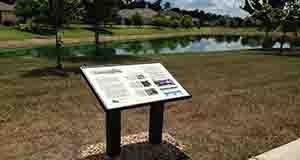Abstract
Installing educational signs is one way to increase awareness and participation in conservation activities. This 6-page fact sheet explains how to create educational signs and install them in residential neighborhoods as a way to inform residents about biodiversity conservation. The fact sheet, one of the UF/IFAS Conservation Subdivision series, explains how to design effective signs, how to manage a series of signs to keep the information fresh, and how to maintain the signs to ensure that residents and visitors to the community continue to benefit and maintain their homes, yards, and neighborhoods sustainably for years to come. Written by Mark Hostetler and published by the Department of Wildlife Ecology and Conservation, January 2016.
References
Hostetler, M., and D. Drake. 2009. "Conservation subdivisions: A wildlife perspective." Landscape and Urban Planning 90:95-101. https://doi.org/10.1016/j.landurbplan.2008.10.018
Hostetler, M.E. 2010. "Beyond design: the importance of construction and post-construction phases in green developments." Sustainability 2:1128-1137. https://doi.org/10.3390/su2041128
Hostetler, M. E. 2012. The Green Leap: A Primer for Conserving Biodiversity in Subdivision Development. Berkeley, CA: University of California Press. https://doi.org/10.1525/california/9780520271104.001.0001
Hostetler, M., E. Swiman, A. Prizzia, and K. Noiseux. 2008. Reaching residents of green communities: Evaluation of a unique environmental education program. Applied Environmental Education & Communication 7(3):114-124. https://doi.org/10.1080/15330150802553828
Lenth, B. A., R. L. Knight, and W. C. Gilgert. 2006. "Conservation value of clustered housing developments." Conservation Biology 20(5):1445-1456. https://doi.org/10.1111/j.1523-1739.2006.00491.x
McElfish, J. M. 2004. Nature-Friendly Ordinances: Local Measures to Conserve Biodiversity. Washington, DC: Environmental Law Institute.
Milder, J. C., J. P. Lassoie, and B. L. Bedford. 2008. "Conserving biodiversity and ecosystem function through limited development: An empirical evaluation." Conservation Biology 22(1):70-79. https://doi.org/10.1111/j.1523-1739.2007.00812.x
Pejchar, L., P. M. Morgan, M. R. Caldwell, C. Palmer, and G. C. Daily. 2007. "Evaluating the potential for conservation development: Biophysical, economic, and institutional perspectives." Conservation Biology 21(1):69-78. https://doi.org/10.1111/j.1523-1739.2006.00572.x

